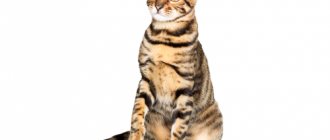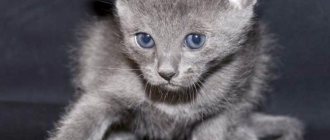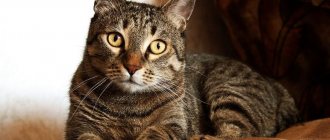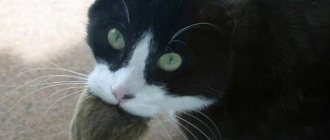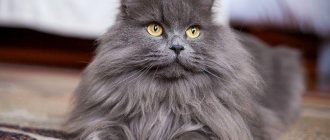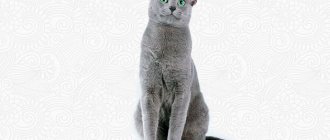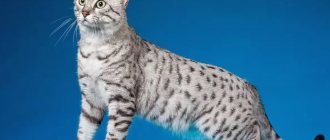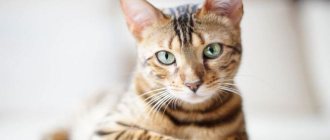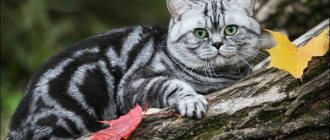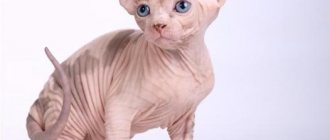Origin story
The Ocicat was born solely at the behest of restless breeders, namely thanks to felinologist Virginia Dale, who suddenly wanted to breed a cat similar to the Siamese, but with a different coat color. For the work, Siamese and Abyssinian cats were taken, respectively, but at some point things took an unexpected turn and an amazing-looking kitten was born: with cream-colored fur, strewn from head to toe with bright contrasting spots.
The cat was named Tongo and, after a while, was put up for sale at a symbolic price. Virginia continued her work, but in a different way: she really liked the spotted color. The next speckled baby, Dalai Dotson, has already received CFA registration.
Over the course of several years (from 1966 to 1980), another hundred spotted babies were born. Others also joined in the breeding of the new breed: American shorthair cats. In 1984, the first breed club was opened, and 2 years later Ocicats won the status of CFA championship.
Also in 1986, the CFA imposed a ban on crossing Ocicats with their close “relatives”: Abyssinian, Siamese and American Shorthair breeds.
Table: advantages and disadvantages of the Ocicat breed
| pros | Minuses |
|
|
Standards
Males of the Ocicat breed look larger in appearance than females and are not as graceful. They weigh about 7 kg, girls - 4-5 kg.
| Standard | Description |
| Head | Wedge-shaped, the skull is elongated in profile, with strong jaws and a clearly defined chin. The whisker pads are plump, and the depression between the pads and cheekbones is also visually noticeable. |
| Ears | They are small, stand upright, and their tips can be decorated with tassels. |
| Eyes | Almond-shaped, open, the color of the iris can be any (one exception - all shades of blue). |
| Torso | Dense but elegant. Outwardly, the animal seems lighter than it actually is. The chest is wide, the back is straight (a small hump between the lumbar region and the croup is allowed). |
| Limbs | Long, muscular. The paws are elongated, with 4 toes on the hind legs and 5 on the front ones. The tail is long and pointed at the tip. |
| Wool | Smooth, very thick and pleasant to the touch. Be sure to tick all hairs. |
Signs due to which an animal is removed from the competition:
- Long or fluffy coat.
- A different color (for example, all shades of red, torby, cream).
- Different number of fingers.
- Blue eyes.
- Tail with loops or creases.
- White fur (exception: in the throat, chin, around the eyes and nostrils).
How to choose the right Ocicat pet
It is quite difficult to purchase an Ocicat, since the breed is rare . There are several nurseries in Russia that breed them (Alma Mater, OciK, Radiant). The minimum cost of an Ocicat kitten, not intended for breeding and exhibition activities, starts from 30 thousand rubles. Breeding animals already cost about 50–100 thousand rubles.
Pedigree Ocicat kittens are not easy to find
When choosing a baby you should consider:
- age (from 14 weeks);
- appearance - clean mucous membranes (ears, eyes and nose without signs of inflammation or any discharge);
- mobility and activity;
- eye color (not blue);
- color - the baby should not have: white spots, except those allowed by the standard;
- pointing Siamese markings;
- tortoiseshell, cream or red (red) colors.
An Ocicat kitten should be inquisitive and active.
For a purebred animal, it is necessary to have a pedigree listing the parents and information about existing defects and hereditary diseases.
A cat lady I know says that there are very few Ocicats in our country and you can buy them only from trusted breeders and based on recommendations. Under no circumstances should you purchase a kitten based on an advertisement. Otherwise, you can easily end up with a mongrel cat passed off as an Ocicat. It will cost suspiciously little, this fact should also definitely alert you.
Colors
According to the standard, 12 acceptable colors are established: chocolate, chocolate-silver, brown, brown with red, brown with yellow, brown-silver, lilac, lilac-silver, blue, blue-silver, beige-silver, black with silver.
The spots on the tail, paws and muzzle should be noticeably darker than the marks on the body. There is a letter "M" on the muzzle. The eyes are outlined in black. The tails of purebred individuals have contrasting transverse stripes.
In the photo there are Ocicat cats of popular colors: red, blue-gray, beige
Cost of a kitten
This is a fairly rare breed for Russia. Nurseries are mostly located in the United States of America and there are a few in France.
A few breeders in Russia will rarely sell even a pet-class kitten for a price below thirty thousand rubles.
If you choose a show animal or breed class, you should definitely inquire about the absence of hereditary diseases and developmental defects in its parents. Special laboratory testing may need to be done.
These individuals will cost much more. They must be accompanied by a purchase and sale agreement, a pedigree and a veterinary passport indicating deworming marks and stamps from the state veterinary clinic on vaccinations against rabies and known viral infections.
Ocicat photo gallery:
1111
Character and behavior
A nimble traveler, knee-deep in the sea - this is how you can briefly describe the Ocicat. Climb higher, run further, find out what is hidden around the next bend and behind that mountain: as they say, don’t feed the Ocicat bread, but let it go free-range, where it will be its own master. However, this cannot be done not only because they will immediately try to steal such a beautiful cat, but also because the fearless Ocicat does not know how to assess risks and can easily get into an unpleasant and even dangerous situation. Approach, for example, a clearly aggressive dog. Or try to jump from a great height.
Representatives of this breed are very affectionate towards people and do not hesitate to show their love and devotion. Of all the family members, he chooses one - the most important for himself - and will remain faithful to him until the end of his life. He also loves other people living side by side with him, but not so selflessly.
He is not afraid of strangers, does not shy away from guests. Even a noisy crowd is not able to embarrass him or force him to hide. He knows how to “talk for life”, and always does it on time. Ocicats subtly sense human mood and, if you clearly have no time for conversation, will quietly sit on the sidelines, waiting for a signal. He does not tolerate loneliness well, even in the company of other cats he quickly becomes bored. The main thing for him is the person, his words and hands.
Ocicats get along with both cats and dogs, but a couple of Ocicats can create an unimaginable mess in your home, so decide what is more important to you: 2 adorable cats or renovation?
If the Ocicat finds an empty bowl, he will not follow you and demand food, but will calmly begin to rummage through the plates and pots that are available to him, try to open the refrigerator or chew on a bag of food.
Ocicats do not become attached to a place and easily tolerate moving. But what they can’t stand is carriers and collars. In the process of accustoming the animal to both the first and second, you will have to be patient.
The same goes for learning tricks. Ocicats quickly grasp information and are happy to do what they like. Babies learn most quickly if there is already an adult and trained animal in the house.
Ocicats are naturally clean and have no problems with the litter box. But if they think their toilet smells bad, they will refuse to go there.
You can also buy an Ocicat kitten in Russia - there are several nurseries in our country - but the cost of one individual will be high. If you are offered an Ocicat kitten for less than 50,000 rubles, this is most likely a scam. But if you want to be sure of the breed: buy a kitten from a foreign nursery.
Education and training
It is customary to write about the learning abilities of Ocicats only that they are smart and quick-witted pets who can easily fetch objects and simple acrobatic tricks. At the same time, it is extremely rare to find information that, like any cats, the descendants of Siamese and Abyssinians are not eager to obey a person and train simply because the owner demands it.
If you decide to get serious about training your Ocicat, come to terms with the need for compromises, which you will have to make often. Some breeders generally recommend relying on the inclinations of the breed, since by stimulating the cat to do what he obviously likes, you dramatically increase your chances of success. For example, Ocicats love to jump, which means that it will not be difficult to teach your pet to take small barriers and fly through a hoop.
The Ocicat has a good memory and excellent self-learning abilities, inherited from the Abyssinians, so the cat quickly learns a list of basic commands. In order for your pet to learn to comply with the requirements “Come to me!”, “Sit!”, “Stand!”, a classic training program is sufficient. Special literature, for example, the book “Training a Cat in 10 Minutes” by Miriam Fields-Bambino or “How to Train Your Cat” by Ellis Bradshaw, will also help you broaden your horizons and learn new techniques for effectively influencing an animal.
Raising a small kitten is easier when a trained adult cat already lives in the house. Submitting to the animal hierarchy, the baby mirrors the behavior of an adult comrade and makes fewer mistakes. If the Ocicat is the only pet in the apartment, the owner will have to take on the role of mentor. As for toilet training your pet, there are no difficulties here. Michigan cats are naturally clean. If there is no usual litter box nearby (for example, on the road), they prefer to be patient or persistently remind them of their needs. Ocicat kittens brought to a new home also quickly get used to the bath with filler and willingly scratch themselves in it, hiding traces of “wet deeds.”
Care instructions
There is no need to buy any special equipment to care for your Ocicat. Nail clipper, shampoo and conditioner, cat toothbrush and toothpaste, cotton swabs, natural bristle comb, ear lotion and cotton pads.
Claws
If your pet sharpens its claws on the scratching post itself, it does not need your help. But if the kitten is small or, on the contrary, old and weak, get involved and shorten its claws 1-2 times a month. Proceed carefully, and if blood vessels are caught, cauterize the cut site with hydrogen peroxide.
Do you trim your pet's nails?
Yes, he’s lazy with us. No, he sharpens himself.
Ears
Ears should be cleaned every week as Ocicats produce a lot of wax. But do not try to pour water or lotion into the cat’s ear: this action provokes otitis media. Soak a cotton swab (whether in a special ear cleaner or in plain boiled water - it makes little difference) and remove discharge and accumulated dirt.
Eyes
Ocicats' eyes rarely run. If the discharge is clear and small, there is no cause for concern. Wipe them from time to time with warm chamomile decoction. But if there is copious, thick or foul-smelling discharge, be sure to take your pet to the doctor.
Wool
Combing once a week is enough. Before the exhibition, the fur can be lightly rubbed with a suede cloth - this procedure will add shine to it.
Teeth
Since the teeth of Ocicats are the weakest point, their care should be thorough and regular.
First, they need to be brushed 2-3 times a week using a small toothbrush and cat toothpaste. Secondly, give special cleansing pads every week for prevention. Thirdly, take him to the veterinary office for ultrasonic teeth cleaning.
Features of mating Ocicats
Females are bred for the first time no earlier than 1 year, otherwise the not fully formed body may not survive pregnancy. Males can be bred after 8 months. The period of gestation and childbirth, as a rule, occurs without problems in Ocicat cats; they are very good mothers and take excellent care of their offspring. A cat can give birth no more than twice during the year.
The Ocicat cat is a wonderful mother, sometimes the babies' father helps her
Individuals unsuitable for breeding must be castrated or sterilized. Usually they try to do this after the onset of puberty (7–8 months). If the operation is performed too early, the pet may be stunted.
Breeding Ocicats is quite difficult due to their small numbers. The potential partner must be:
- completely healthy;
- timely vaccinated and dewormed;
- purebred - have the appropriate documents (pedigree, club membership book, etc.);
- the same or similar color.
As my friend, a cat breeder, advises, it is better to look for a suitable match for your pet in specialized nurseries or from experienced breeders with good reviews.
It is quite difficult to find a mate for an Ocicat, since there are few such cats.
The probability of breeding a marriage is very high, so it is better to first consult with an experienced felinologist, who will tell you what kind of partner you need (by color) and where he can be found.
Catering
Active Ocicats do not suffer from lack of appetite and are not prone to obesity. But this does not mean that you can feed them anything and put huge portions in bowls “in reserve.” The basic rules are:
- Food for the Ocicat should be coarse enough to remove plaque from the teeth and massage the gums.
- Animal protein – at least 70%.
- For castrated and sterilized animals, the amount of carbohydrates should be kept to a minimum.
- Water is the only thing you can give an Ocicat. It must be clean (bottled, settled, or passed through a special filter), at a comfortable temperature, and odorless. Wash the bowl and change the water 2 times a day: morning and evening, and when it gets dirty.
- Do not mix natural and prepared food: this creates additional stress on the digestive system. Choose one thing.
Natural products
You need to be able to choose the right products, prepare them properly, know in what quantities and to whom to give them.
You cannot feed cats food from your table: fatty, sweet, salty foods, it is forbidden to give smoked meats, many vegetables (eggplants, pure potatoes, tomatoes), legumes, juices, citrus fruits, baked goods, canned food, seasonings, sugar, salt, sauces, alcohol, products with preservatives and additives. And chocolate and eggplants are deadly for cats, as are tubular bones!
List of permitted products:
- Fish (salmon, trout, chum salmon, cod, tuna, pink salmon, flounder, halibut, sardine). Scales, fins and heads are removed from the fish, frozen for 2-3 days before consumption, then cut into pieces and boiled or served raw. You can’t give it more than once a week: excess iodine leads to hyperthyroidism, histamine – to allergies, fatty acids – to inflammation and panniculitis.
- Lean meat and offal (beef tenderloin, veal, chicken necks and breasts, rabbit, turkey, kidneys, liver, hearts, horse meat, soft cartilage). Meat, like fish, is frozen and then doused with boiling water or boiled.
- Low-fat dairy products (cottage cheese, fermented baked milk, cream, kefir, yogurt, sour cream, natural yogurt).
- Porridge (buckwheat, oatmeal, pearl barley, millet, rice). Boil in water, do not add sugar, salt or seasonings. You can add milk, but not much (solely for taste).
- Boiled chicken eggs (yolk), quail eggs (whole).
- Vegetables (pumpkin, carrots, zucchini, asparagus, broccoli, green peas, cauliflower, spinach, beets, squash, parsley, green salad, dill, cucumbers).
Recommended food
Industrial ready-made food is often chosen by owners who, due to their busy lives, cannot devote much time to cooking and counting nutrients. But there are so many bright packages on store shelves that it is sometimes difficult to make a choice.
But don't believe the advertising! If you have the financial opportunity, buy holistic food for your pet. They are the most expensive, but the quality is an order of magnitude higher than all the others. For their production, high-quality products, natural preservatives, high-quality vitamin and mineral supplements are used, and there are no dangerous chemical compounds, flavor enhancers or dyes. Examples: Power of Nature, Wellness CORE, Now Fresh.
Super-premium food is a little cheaper. The composition is somewhat different from holistic food: pea or potato protein and rosemary are often added to super-premium food as a preservative. Examples: Mealfeel, Natyka, Pronature Life, Summit.
Below are the recommended holistic and super-premium foods. Links with the names of the food are clickable, on them you can, within our website, get acquainted with the descriptions of the food and read reviews from owners of Ocicat cats.
| Super premium | Holistic | Super premium |
| Pure Life | Alleva Holistic | VetSolution |
Mr. Cat recommends: Character
If you decide to have a domestic and highly social cat with a predatory color in your apartment, then you should know about the peculiarities of its temperament:
- Outwardly it seems small, but if you take the cat in your arms, it is unexpectedly heavy - under the smooth shiny fur, tightly adjacent to the body, there are solid muscles. Ready to take off at any moment and rush to play.
- Unpretentious in everything - in food and maintenance.
- A highly social creature, never shying away from new people. Moderately curious, always interested in everything.
- Very active and constantly on the move. Needs companionship either with a person or with another pet. You need a lot of toys and preferably exercise equipment.
- Highly intelligent, persistent researcher. He will quickly learn and will open doors, boxes, drawers with enviable tenacity and perseverance.
- He loves to travel and enjoys driving with his owner.
- A cat with his own opinion about everything. Will not tolerate coercion in anything. He will come when he wants to chat. You won't be able to pick him up by force.
- Quite talkative, but not as talkative as the Siamese. The Abyssinian also does not suffer from excessive obsession.
- With small children he will be reserved and aloof. He doesn't want to be a toy for anyone. With a wild appearance, this cat surprisingly acquired the dignity of a predator.
Diseases
By cat standards, Ocicats live a long life: 15-18 years. But they have genetic problems, which is not surprising: after all, when breeding the breed, as many as 3 breeds of cats were used!
- Firstly, renal amyloidosis is often diagnosed in Ocicats. This disease is quite rare, but very dangerous: the body stops processing protein correctly. Metabolism is disrupted, the kidneys suffer, and renal failure occurs. The animal loses weight, weakens, its urine becomes thick with blood, constipation or diarrhea appears, the temperature rises, the hair becomes dull and falls out. It is impossible to cure the disease, but it is possible to alleviate the cat’s condition, as well as extend life for several years.
- The second problem is pyruvate kinase deficiency (PK-Def) - an autosomal recessive disease, anemia, in other words. Symptoms vary (lack of appetite, weakness, weight loss, drowsiness, spleen tumor). Medicines improve quality of life.
- The third problem is gum disease (gingivitis). It was transmitted to Ocicats from both Abyssinian and Siamese cats. Gingivitis leads to tooth loss, so preventive measures must be followed very strictly.
Expert opinion
Dusheba Vera Ivanovna
In 2010, she graduated from the Moscow State Academy of Veterinary Medicine named after K.I. Scriabin with honors, specializing in veterinary medicine. I regularly attend veterinary conferences, congresses, and webinars.
The deworming procedure should be carried out even if your cat does not go for walks. Worm eggs can enter his body even with food (through chicken, pork, fish), from your outdoor shoes, or through fleas. Medicines should be given only after consultation with a veterinarian, since the age, weight, and general condition of the animal are taken into account (medications should not be given to kittens under 20 weeks of age, and with extreme caution to lactating cats and pregnant women).
All of the above applies to vaccination. Diseases such as panleukopenia, rhinotracheitis, calcivirosis, rabies and others are deadly for cats. For some time, kittens are protected by mother's milk, but when they reach the age of 16 weeks, the effect disappears. Vaccination provides lasting immunity and reliable protection, but you shouldn’t give your cat injections yourself - trust this matter to your doctor!
Ocicat Health
In general, Ocicats have good immunity and good health, with an average life expectancy of about 18–20 years. But since they were bred artificially, as a result of numerous crossings between different cat breeds, they received some genetic diseases and hereditary predispositions:
- hypertrophic cardiomyopathy (sudden and sudden death, often before the age of 5 years);
- liver amyloidosis (protein deposits accumulate in the liver, leading to liver failure);
- hemolytic anemia (instability and destruction of red blood cells);
- renal amyloidosis (developing renal failure due to impaired protein metabolism);
- retinal atrophy (degeneration of photoreceptors), leading to vision loss;
- gingivitis and periodontal disease, as well as increased formation of sedimentary tartar.
Veterinarians advise brushing Ocicats’ teeth more often to remove tartar in a timely manner.
It is strongly recommended that you take your Ocicat to the clinic at least once a year to be examined by a veterinarian.
Photo gallery
Below are photos of Ocicat cats.
Care and feeding of cats
This is the same breed that does not require any special care. The coat requires attention only during shedding. The rest of the time, you don’t even need to comb it, the fur coat is good on its own. There is no undercoat, this eliminates a number of maintenance problems. If you really want to, you can polish the fur with a piece of suede.
It is very necessary to organize a place for games: the animal’s energy often goes through the roof. For health, the cat needs to be walked and engaged in active games.
Proper feeding of an Ocicat includes high-quality, balanced food. You don’t need to look for any recipes, this will be enough. Accordingly, there should always be clean, fresh water in the bowl.
Cat character - description
The character of the pets is especially interesting. Ocicats can simultaneously be active with well-developed hunting qualities and very calm and obedient. Cats quickly become attached to their owners and find loneliness difficult. They should not be owned by people who spend little time at home.
The voice is melodic and quiet. Pets are quite intelligent and inquisitive, so they are easy to teach to various household habits (going to the toilet, following commands). They are distinguished by their mischievous and playful nature. Having decided to get an Ocicat, the owner will not be faced with the “lying” lifestyle of the pet.
The Ocicat cat is not distinguished by its favorability towards intrusive actions on the part of others. As a rule, she tries to find a secluded place to avoid unpleasant contacts. For families with small children, it is best to give preference to another breed.
Ocicats do not tolerate competition with other dominant cats. However, they easily find a common language with other animals due to their natural curiosity - for example, dogs, turtles, parrots.
Breed overview
WEIGHT : from 3 to 7 kg
LENGTH : from 40 to 45 cm
HAIR : short
COAT COLOR : tabby with blue spots, blue/silver spots, lavender spots, lavender/silver spots, cinnamon spots, cinnamon/silver spots, fawn spots, fawn/silver spots, chocolate spots, chocolate/silver spots, with silver spots and brown spots
EYE COLOR : All colors framed by eyeliner.
How long do they live : from 10 to 15 years
Color
Experts distinguish 12 color types of Ocicats. Many people who are far from felinology cannot discern all the nuances.
- Red-brown. Black or dark brown spots are scattered throughout the brick-bronze tone. The main wool is not monochromatic, but has a natural fine agouti pattern, in which each wool has several zoned differently colored stripes.
- Chocolate. Light ivory agouti has chestnut spots. The tip of the tail is the same color.
- Blue. The spots and cap on the tail are gray-blue, the body is colored a pale yellow or bluish agouti shade.
- Lilac. Purple spots are scattered on a pale yellow or milky background.
- Yellowish brown. The main color of the coat of the yellow-brown Ocicat Agouti is ivory, the pattern on the body is sandy-ocher.
- Silver-black. Perhaps the most contrasting of all colors. Black or dark gray spots and stripes decorate the silver or white agouti base coat.
The remaining variations differ only in the color scheme of the design on a white background:
- Silver chocolate. The spots and tip of the tail are chocolate-colored.
- Silver-brown. Cinnamon color drawing.
- Silver blue. The spots and tip of the tail are blue.
- Silver-purple. The color of the pattern is lavender-lilac.
- Silver beige. The spots, half rings and cap on the tail are a delicate fawn color.
